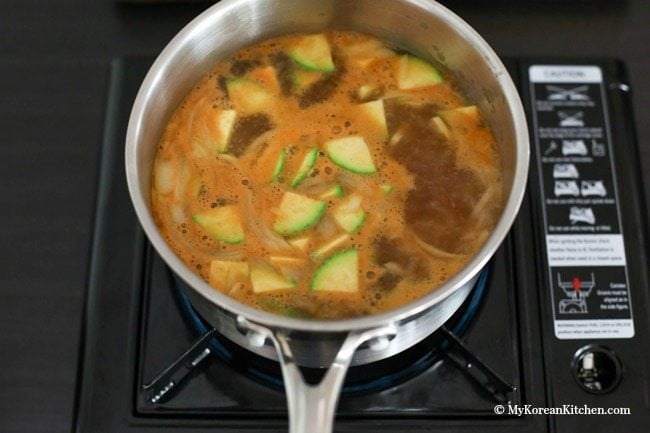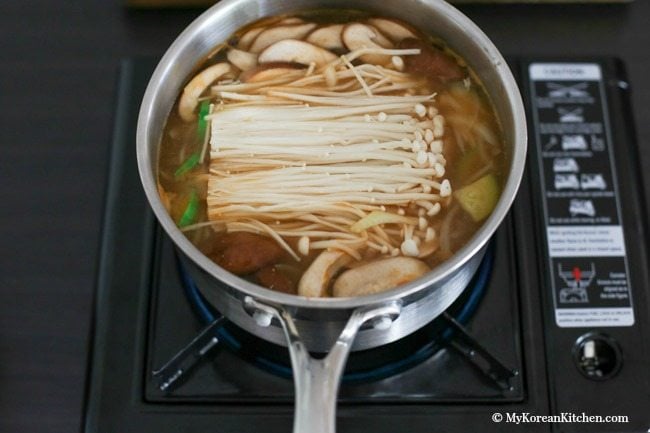Learn how to make everyday Korean soup – Korean soybean paste soup!
 Today I’m sharing Korea’s most staple soup – Doenjang Guk (된장국, Korean soybean paste soup/ Korean miso soup). As I was growing up, I think I had various versions of Doenjang Guk at least a couple of times a week, if not every day! Yeah, it’s such a commonly consumed soup in every Korean household, so you’ve got to try this!
Today I’m sharing Korea’s most staple soup – Doenjang Guk (된장국, Korean soybean paste soup/ Korean miso soup). As I was growing up, I think I had various versions of Doenjang Guk at least a couple of times a week, if not every day! Yeah, it’s such a commonly consumed soup in every Korean household, so you’ve got to try this!
Difference between Doenjang Guk (된장국) and Doenjang Jjigae (된장찌개)
I thought you might be wondering about the difference between Doenjang Guk and Doenjang Jjigae? Well, my simple answer is Doenjang Guk is Korean soybean paste soup and Doenjang Jjigae is Korean soybean paste stew. Guk (국) tends to have more water/stock/broth in comparison to the rest of the ingredients (vegetables and/or meat) than Jjigae (찌개).
This implies, not always though, that Jjigae usually has a stronger taste (may be even slightly saltier or spicier) than Guk. Also Guk is typically served in an individual serving bowl but usually Jjigae is served in earthenware and it is placed in the centre of the dinning table. People will share a spoonful of this Jjigae during the meal. However people do use the term Doenjang Guk and Doenjang Jjigae interchangeably as well.
There are different variations of soybean paste soup, but today’s recipe is a very basic kind – Tofu and zucchini Korean soybean paste soup (Dubu Hobak Doenjang Guk, 두부 호박 된장국).
In the recipe, I used my homemade dashi stock, which I recently shared with you and I only used Korean soybean paste (Doenjang, 된장), Korean chili paste (Gochujang, 고추장) and garlic as soup seasoning. It’s mild (maybe with very subtle spiciness, which I really didn’t notice) but nonetheless tasty, hearty and comforting. It’s my go to soup when I need a quick Korean food fix lately. I hope you like it too!
Ingredients for Korean Soybean Paste Soup (4 servings)
- 1/2 large (145g, 5.1 ounces) zucchini (I used Korean zucchini (Aehobak, 애호박). I often find that a regular zucchini has a slightly bitter taste.) – thinly sliced and cut into quarter circles
- 4 small (50g, 1.8 ounces) shiitake mushrooms -rinsed, stem removed and thinly sliced (You can use the stem when making the stock.)
- 1 pack (200g, 7.1 ounces) enoki mushrooms – bottom 4-5 cm stem removed and rinsed briefly in cold running water
- 1/2 small (35g, 1.2 ounces) brown onion – diced
- 250g (8.8 ounces) Korean tofu – medium firm – diced or cut into small rectangular pieces
- Dried kelp and dried anchovy stock (Korean soup stock) – About 4 and 1/2 cup.
- Soup seasoning sauce (mix these well in a small bowl)
- 3 Tbsp Korean soybean paste (Doenjang, 된장)
- 1 tsp Korean chili paste (Gochujang, 고추장)
- 1 tsp minced garlic
*1 Tbsp= 15ml, 1 cup = 250ml
**If you want to learn more about Korean ingredients, check my 30 essential Korean cooking ingredients list!
How to Make Korean Soybean Paste Soup (Doenjang Guk)
1. Start boiling the dried kelp and dried anchovy stock (Korean style dashi) on high heat in a sauce pan. – It takes about 5 to 6 mins to rolling boil based on refrigerated stock. If you’re using freshly boiled stock, it takes 3 to 4 mins to rolling boil.
2. Soon after adding the stock into a sauce pan, sieve through the soup seasoning sauce so that it blends well with the stock. Once you sieve through, you will notice some large particles from the soybean paste in the sieve. I personally like having my soup clear, so I discard this. But if you like, you can add this back into the soup.  3. Once the broth starts to rolling boil, reduce the heat to medium and add the zucchini and the onion. Boil them for 2 to 3 mins.
3. Once the broth starts to rolling boil, reduce the heat to medium and add the zucchini and the onion. Boil them for 2 to 3 mins.  4. Add the tofu and boil for a further 1 to 2 mins.
4. Add the tofu and boil for a further 1 to 2 mins.  5. Add the shiitake mushroom and enoki mushrooms and boil for last the 1 to 2 mins.
5. Add the shiitake mushroom and enoki mushrooms and boil for last the 1 to 2 mins.  6. Turn the heat off and serve.
6. Turn the heat off and serve. 
Note
- Typical Korean earthenware that are available for soup and stew are usually only enough for one to two servings. But since I cooked for 4 servings, I cooked everything in a sauce pan and transferred some to my earthenware for the photo shoot. Also please note that if you use earthenware to cook this soup, the boiling point might be faster than the sauce pan. It is also prone to overflow if you fail to adjust the heat quickly.
- An alternative way to making the stock from scratch is you can buy the (healthy) powder version of stock and add it when boiling the water. In this case, follow the manufacturer’s instructions. Just note that the taste of the soup might be different to mine.
- I used a standard version (without extra added seasoning or flavour) of Korean soybean paste and Korean chili paste that are readily available from a Korean grocery store. If you use a homemade version (which tends to have a slightly stronger flavour and smell) or a varied version with extra spice and/or seasoning, the outcome of the soup will be different. If you’re using these kinds, I recommend using less than what my recipe calls for.
- If you want this soup to be spicy, add some (1/2 tsp to 1 tsp) Korean chili flakes (Gochugaru, 고추가루) in your soup seasoning mix. You can also add some sliced Korean green or red chili just before you serve.

Korean Soybean Paste Soup (Doenjang Guk)
Ingredients
Main
- 1/2 large zucchini (145 g / 5.1 ounces), I used Korean zucchini (also known as summer squash). I often find that a regular zucchini has a slightly bitter taste. – thinly sliced and cut into quarter circles
- 4 small shiitake mushrooms (50 g / 1.8 ounces), rinsed, stem removed and thinly sliced (You can use the stem when making the stock.)
- 1 pack enoki mushrooms (200 g / 7.1 ounces), bottom 4-5 cm stem removed and rinsed briefly in cold running water
- 1/2 small brown onion (35 g / 1.2 ounces), diced
- 250 g Korean tofu (8.8 ounces), medium firm, diced or cut into small rectangular pieces
- 4 1/2 cup Dried kelp and dried anchovy stock (Korean style dashi)
Soup seasoning sauce (mix these well in a small bowl)
- 3 Tbsp Korean soybean paste (Doenjang)
- 1 tsp Korean chili paste (Gochujang)
- 1 tsp minced garlic
Instructions
- Start boiling the dried kelp and dried anchovy stock (Korean style dashi) on high heat in a sauce pan. – It takes about 5 to 6 mins to rolling boil based on refrigerated stock. If you’re using freshly boiled stock, it takes 3 to 4 mins to rolling boil.
- Soon after adding the stock into a sauce pan, sieve through the soup seasoning sauce so that it blends well with the stock. Once you sieve through, you will notice some large particles from the soybean paste in the sieve. I personally like having my soup clear, so I discard this. But if you like, you can add this back into the soup.
- Once the broth starts to rolling boil, reduce the heat to medium and add the zucchini and the onion. Boil them for 2 to 3 mins.
- Add the tofu and boil for a further 1 to 2 mins.
- Add the shiitake mushroom and enoki mushrooms and boil for last the 1 to 2 mins.
- Turn the heat off and serve.
Nutrition Info (per serving)
The nutrition information shown is an estimate provided by an online nutrition calculator. It should not be considered a substitute for a professional nutritionist’s advice.


